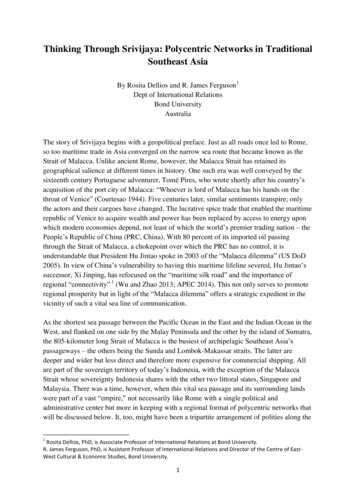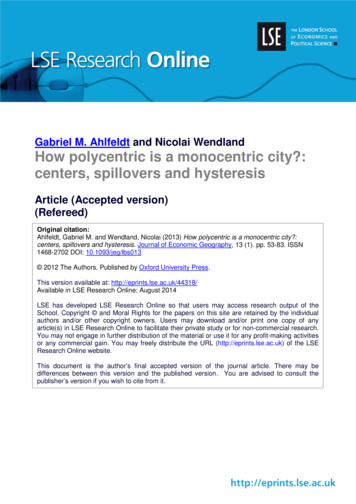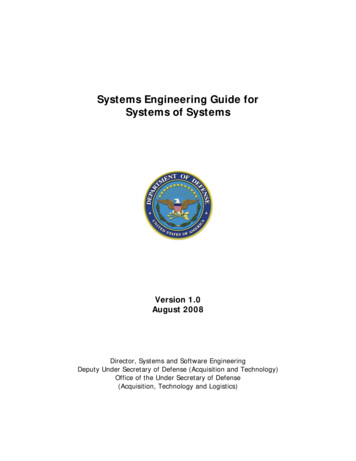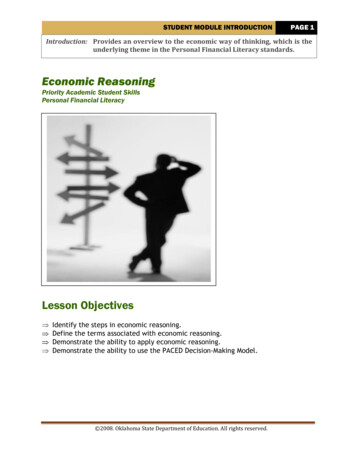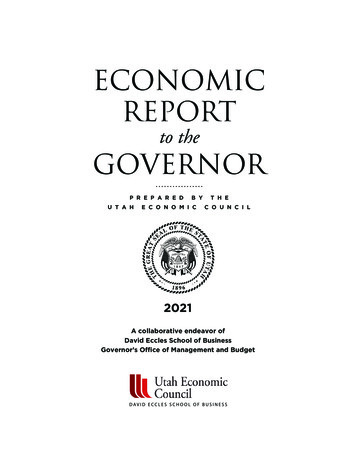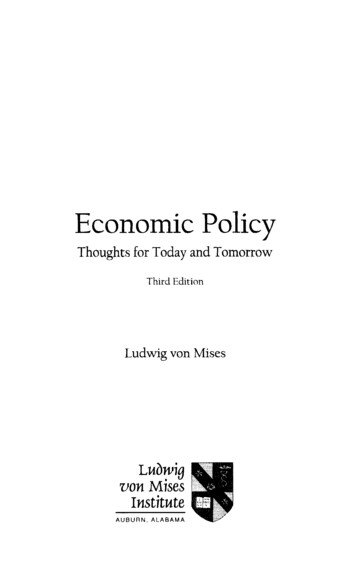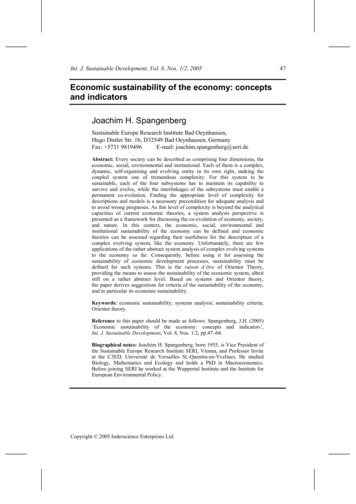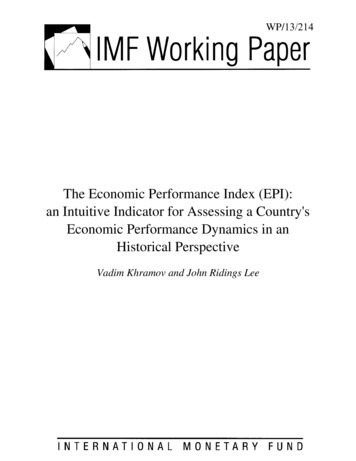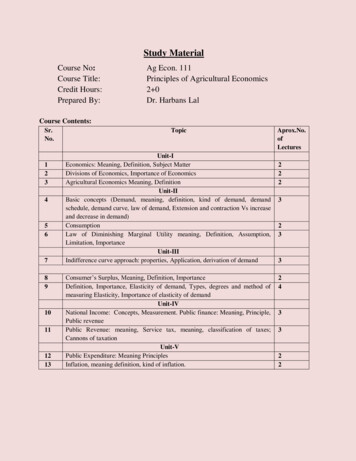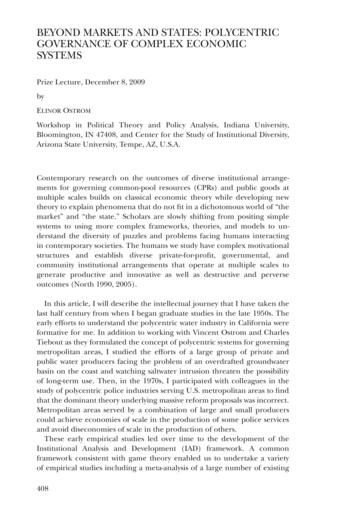
Transcription
Beyond Markets and States: PolycentricGovernance of Complex EconomicSystemsPrize Lecture, December 8, 2009byElinor OstromWorkshop in Political Theory and Policy Analysis, Indiana University,Bloomington, IN 47408, and Center for the Study of Institutional Diversity,Arizona State University, Tempe, AZ, U.S.A.Contemporary research on the outcomes of diverse institutional arrangements for governing common-pool resources (CPRs) and public goods atmultiple scales builds on classical economic theory while developing newtheory to explain phenomena that do not fit in a dichotomous world of “themarket” and “the state.” Scholars are slowly shifting from positing simplesystems to using more complex frameworks, theories, and models to understand the diversity of puzzles and problems facing humans interactingin contemporary societies. The humans we study have complex motivationalstructures and establish diverse private-for-profit, governmental, andcommunity institutional arrangements that operate at multiple scales togenerate productive and innovative as well as destructive and perverseoutcomes (North 1990, 2005).In this article, I will describe the intellectual journey that I have taken thelast half century from when I began graduate studies in the late 1950s. Theearly efforts to understand the polycentric water industry in California wereformative for me. In addition to working with Vincent Ostrom and CharlesTiebout as they formulated the concept of polycentric systems for governingmetropolitan areas, I studied the efforts of a large group of private andpublic water producers facing the problem of an overdrafted groundwaterbasin on the coast and watching saltwater intrusion threaten the possibilityof long-term use. Then, in the 1970s, I participated with colleagues in thestudy of polycentric police industries serving U.S. metropolitan areas to findthat the dominant theory underlying massive reform proposals was incorrect.Metropolitan areas served by a combination of large and small producerscould achieve economies of scale in the production of some police servicesand avoid diseconomies of scale in the production of others.These early empirical studies led over time to the development of theInstitutional Analysis and Development (IAD) framework. A commonframework consistent with game theory enabled us to undertake a varietyof empirical studies including a meta-analysis of a large number of existing408
case studies on common-pool resource systems around the world. Carefullydesigned experimental studies in the lab have enabled us to test precisecombinations of structural variables to find that isolated, anonymous individuals overharvest from common-pool resources. Simply allowing communication, or “cheap talk,” enables participants to reduce overharvesting andincrease joint payoffs, contrary to game-theoretical predictions. Large studiesof irrigation systems in Nepal and forests around the world challenge thepresumption that governments always do a better job than users in organizingand protecting important resources.Currently, many scholars are undertaking new theoretical efforts. A core effort is developing a more general theory of individual choice that recognizesthe central role of trust in coping with social dilemmas. Over time, a clearset of findings from the microsituational level has emerged regardingstructural factors affecting the likelihood of increased cooperation. Dueto the complexity of broader field settings, one needs to develop moreconfigural approaches to the study of factors that enhance or detract fromthe emergence and robustness of self-organized efforts within multilevel,polycentric systems. Further, the application of empirical studies to the policyworld leads one to stress the importance of fitting institutional rules to aspecific social-ecological setting. “One-size-fits-all” policies are not effective.1. The Earlier World View of Simple SystemsIn the mid-twentieth century, the dominant scholarly effort was to try to fitthe world into simple models and to criticize institutional arrangements thatdid not fit. I will briefly review the basic assumptions that were made at thattime but have been challenged by scholars around the world, including thework of Herbert Simon (1955) and Vincent Ostrom (2008).A. Two Optimal Organizational FormsThe market was seen as the optimal institution for the production andexchange of private goods. For nonprivate goods, on the other hand, oneneeded “the” government to impose rules and taxes to force self-interestedindividuals to contribute necessary resources and refrain from self-seekingactivities. Without a hierarchical government to induce compliance, selfseeking citizens and officials would fail to generate efficient levels of publicgoods, such as peace and security, at multiple scales (Hobbes [1651] 1960;W. Wilson 1885). A single governmental unit, for example, was stronglyrecommended to reduce the “chaotic” structure of metropolitan governance,increase efficiency, limit conflict among governmental units, and best serve ahomogeneous view of the public (Anderson and Weidner 1950; Gulick 1957;Friesema 1966). This dichotomous view of the world explained patterns ofinteraction and outcomes related to markets for the production and exchangeof strictly private goods (Alchian 1950), but it has not adequately accountedfor internal dynamics within private firms (Williamson 1975, 1986). Nor doesit adequately deal with the wide diversity of institutional arrangements that409
humans craft to govern, provide, and manage public goods and commonpool resources.B. Two Types of GoodsIn his classic definitional essay, Paul Samuelson (1954) divided goodsinto two types. Pure private goods are both excludable (individual A can beexcluded from consuming private goods unless paid for) and rivalrous(whatever individual A consumes, no one else can consume). Public goodsare both nonexcludable (impossible to keep those who have not paid for agood from consuming it) and nonrivalrous (whatever individual A consumesdoes not limit the consumption by others). This basic division was consistentwith the dichotomy of the institutional world into private property exchangesin a market setting and government-owned property organized by a publichierarchy. The people of the world were viewed primarily as consumers orvoters.C. One Model of the IndividualThe assumption that all individuals are fully rational was generally acceptedin mainstream economics and game theory. Fully rational individuals arepresumed to know (1) all possible strategies available in a particular situation,(2) which outcomes are linked to each strategy given the likely behavior ofothers in a situation, and (3) a rank order for each of these outcomes interms of the individual’s own preferences as measured by utility. The rationalstrategy for such an individual in every situation is to maximize expectedutility. While utility was originally conceived of as a way of combining a diversity of external values on a single internal scale, in practice, it has come tobe equated with one externalized unit of measure – such as expected profits.This model of the individual has fruitfully generated useful and empiricallyvalidated predictions about the results of exchange transactions related togoods with specific attributes in a competitive market but not in a diversityof social dilemmas. I will return to a discussion of the theory of individualbehavior in section 7A.2. Early Efforts to Develop a Fuller Understanding ofComplex Human SystemsThe mid-twentieth-century world views of simple systems have slowly beentransformed as a result of extensive empirical research and the developmentof a framework consistent with game-theoretical models for the analysis of abroad array of questions.A. Studying Polycentric Public IndustriesUndertaking empirical studies of how citizens, local public entrepreneurs,and public officials engage in diverse ways of providing, producing, andmanaging public service industries and common-property regimes atmultiple scales has generated substantial knowledge that is not explained410
by two models of optimal organizational forms. Vincent Ostrom, CharlesTiebout, and Robert Warren (1961) introduced the concept of polycentricityin their effort to understand whether the activities of a diverse array ofpublic and private agencies engaged in providing and producing of publicservices in metropolitan areas was chaotic, as charged by other scholars – orpotentially a productive arrangement.‘Polycentric’ connotes many centers of decision making that areformally independent of each other. Whether they actually functionindependently, or instead constitute an interdependent system ofrelations, is an empirical question in particular cases. To the extentthat they take each other into account in competitive relationships,enter into various contractual and cooperative undertakings or haverecourse to central mechanisms to resolve conflicts, the various politicaljurisdictions in a metropolitan area may function in a coherent mannerwith consistent and predictable patterns of interacting behavior. Tothe extent that this is so, they may be said to function as a ‘system’.(V. Ostrom, Tiebout, and Warren 1961: 831–32)Drawing on the concept of a public service industry (Bain 1959; Caves1964; V. Ostrom and E. Ostrom 1965), several studies of water industryperformance were carried out in diverse regions of California during the1960s (V. Ostrom 1962; Weschler 1968; Warren 1966; E. Ostrom 1965).Substantial evidence was found that multiple public and private agencieshad searched out productive ways of organizing water resources at multiplescales contrary to the view that the presence of multiple governmental unitswithout a clear hierarchy was chaotic. Further, evidence pointed out threemechanisms that increase productivity in polycentric metropolitan areas: (1)small- to medium-sized cities are more effective than large cities in monitoring performance of their citizens and relevant costs, (2) citizens who aredissatisfied with service provision can “vote with their feet” and move tojurisdictions that come closer to their preferred mix and costs of publicservices, and (3) local incorporated communities can contract with largerproducers and change contracts if not satisfied with the services provided,while neighborhoods inside a large city have no voice.In the 1970s, the earlier work on effects of diverse ways of organizing theprovision of water in metropolitan areas was extended to policing and publicsafety. We found that while many police departments served 80 metropolitanareas that we studied, duplication of services by more than one departmentto the same set of citizens rarely occurred (E. Ostrom, Parks, and Whitaker1978). Further, the widely held belief that a multiplicity of departmentsin a metropolitan area was less efficient was not found. In fact, the “mostefficient producers supply more output for given inputs in high multiplicitymetropolitan areas than do the efficient producers in metropolitan areaswith fewer producers” (E. Ostrom and Parks 1999: 287). Metropolitan areaswith large numbers of autonomous direct service producers achieved higher411
levels of technical efficiency (ibid.: 290). Technical efficiency was also enhanced in those metropolitan areas with a small number of producers providing indirect services such as radio communication and criminal laboratoryanalyses. We were able to reject the theory underlying the proposals of themetropolitan reform approach. We demonstrated that complexity is not thesame as chaos in regard to metropolitan governance. That lesson has carriedforth as we have undertaken further empirical studies of polycentric governance of resource and infrastructure systems across the world (Anderssonand Ostrom 2008; E. Ostrom, Schroeder, and Wynne 1993).B. Doubling the Types of GoodsStudying how individuals cope with diverse public problems in the world ledus to reject Samuelson’s two-fold classification of goods. Buchanan (1965)had already added a third type of good, which he called “club goods.” Inrelation to these kinds of goods, it was feasible for groups of individualsto create private associations (clubs) to provide themselves nonrivalrousbut small-scale goods and services that they could enjoy while excludingnonmembers from participation and consumption of benefits.In light of further empirical and theoretical research, we proposedadditional modifications to the classification of goods to identify fundamentaldifferences that affect the incentives facing individuals (V. Ostrom and E.Ostrom 1977).1. Replacing the term “rivalry of consumption” with “subtractability ofuse.”2. Conceptualizing subtractability of use and excludability to vary fromlow to high rather than characterizing them as either present or ab sent.3. Overtly adding a very important fourth type of good – common-poolresources – that shares the attribute of subtractability with privategoods and difficulty of exclusion with public goods (V. Ostrom and E.Ostrom 1977). Forests, water systems, fisheries, and the global atmos- phere are all common-pool resources of immense importance forthe survival of humans on this earth.4. Changing the name of a “club” good to a “toll” good, since manygoods that share these characteristics are provided by small-scalepublic as well as private associations.Figure 1 provides an overview of four broad types of goods that differentially affect the problems individuals face in devising institutions to enablethem to provide, produce, and consume diverse goods. These four broadtypes of goods contain many subtypes of goods that vary substantially inregard to many attributes. For example, a river and a forest are both commonpool resources. They differ substantially, however, in regard to the mobilityof the resource units produced, the ease of measurement, the time scale forregeneration, and other attributes. Specific common-pool resources alsodiffer in regard to spatial extent, number of users, and many other factors.412
Subtractability of UseHighDifficulty of HighExcludingPotentialBeneficiariesLowCommon-pool resources:groundwater basins, lakes,irrigation systems, fisheries,forests, etc.Private goods: food, clothing,automobiles, etc.LowPublic goods: peace and securityof a community, national defense,knowledge, fire protection,weather forecasts, etc.Toll goods: theaters, private clubs,daycare centersFigure 1. Four types of goods. Source: Adapted from E. Ostrom, 2005: 24.When one engages in substantial fieldwork, one confronts an immensediversity of situations in which humans interact. Riding as an observer in apatrol car in the central district of a large American city at midnight on aSaturday evening, one sees different patterns of human interaction than in asuburb on a weekday afternoon when school is letting out. In both cases, oneobserves the production of a public good – local safety – by an official of alocal government. Others who are involved in each situation differ in regardto age, sobriety, why they are there, and what they are trying to accomplish.And this context affects the strategies of the police officer one is observing.Contrast observing the production of a public good to watching privatewater companies, city utilities, private oil companies, and local citizensmeeting in diverse settings to assess who is to blame for overdrafting theirgroundwater basin, causing massive saltwater intrusion, and what to do next.These individuals all face the same problem – the overdraft of a commonpool resource – but their behavior differs substantially when they meetmonthly in a private water association, when they face each other in a courtroom, and when they go to the legislature and eventually to the citizens tosponsor a Special Replenishment District. These and many other situationsobserved in irrigation systems and forests in multiple countries do not closelyresemble the standard models of a market or a hierarchy.3. Developing a Framework for Analyzing the Diversity ofHuman SituationsThe complexity and diversity of the field settings we have studied has generated an extended effort by colleagues associated with the Workshop in PoliticalTheory and Policy Analysis (the Workshop) to develop the IAD framework (V.Ostrom 1975; Kiser and Ostrom 1982; McGinnis 1999a, b, 2000; E. Ostrom1986, 2005). The framework contains a nested set of building blocks thatsocial scientists can use in efforts to understand human interactions and outcomes across diverse settings. The IAD builds on earlier work on transactions(Commons [1924] 1968), logic of the situation (Popper 1961), collective structures (Allport 1962), frames (Goffman 1974), and scripts (Schank and Abelson1977). The approach also draws inspiration from the work of Koestler(1973) and Simon (1981, 1995), who both challenged the assumption413
that human behavior and outcomes are entirely based on a small set ofirreducible building blocks.While the terms frameworks, theories, and models are used interchangeably by many scholars, we use these concepts in a nested manner to rangefrom the most general to the most precise set of assumptions made by ascholar. The IAD framework is intended to contain the most general set ofvariables that an institutional analyst may want to use to examine a diversity of institutional settings including human interactions within markets,private firms, families, community organizations, legislatures, and governmentagencies. It provides a metatheoretical language to enable scholars to discussany particular theory or to compare theories.A specific theory is used by an analyst to specify which working parts of aframework are considered useful to explain diverse outcomes and how theyrelate to one another. Microlevel theories including game theory, microeconomic theory, transaction cost theory, and public goods/common-poolresource theories are examples of specific theories compatible with the IADframework. Models make precise assumptions about a limited number ofvariables in a theory that scholars use to examine the formal consequences ofthese specific assumptions about the motivation of actors and the structureof the situation they face.The IAD framework is designed to enable scholars to analyze systems thatare composed of a cluster of variables, each of which can then be unpackedmultiple times depending on the question of immediate interest. At thecore of the IAD framework is the concept of an action situation affected byexternal variables (see Figure 2). The broadest categories of external factorsaffecting an action situation at a particular time include:1. Biophysical conditions, which may be simplified in some analyses to beone of the four types of goods defined in Figure 1.2. Attributes of a community, which may include the history of priorinteractions, internal homogeneity or heterogeneity of key attributes, andthe knowledge and social capital of those who may participate or beaffected by others.3. Rules-in-use, which specify common understanding of those involvedrelated to who must, must not, or may take which actions affecting otherssubject to sanctions (Crawford and Ostrom 2005). The rules-in-use mayevolve over time as those involved in one action situation interact withothers in a variety of settings (E. Ostrom 2008; E. Ostrom and Basurtoforthcoming; Boyd and Richerson 1985) or self-consciously change therules in a collective-choice or constitutional-choice setting.The set of external variables impacts an action situation to generate patternsof interactions and outcomes that are evaluated by participants in the actionsituation (and potentially by scholars) and feed back on both the externalvariables and the action situation.414
External VariablesBiophysicalConditionsAttributes riteriaRules-in-UseOutcomesFigure2.2.AA frameworkframework forforinstitutionalanalysis.Source:Source:Adapted Adaptedfrom E. Ostrom,15.Figureinstitutionalanalysis.from 2005:E. Ostrom,2005:15.The internal working parts of an action situation are overtly consistent withthe variables that a theorist uses to analyze a formal game.1 This has meantthat colleagues have been able to use formal game theory models consistentwith the IAD framework to analyze simplified but interesting combinations oftheoretical variables and derive testable conclusions from them (see Achesonand Gardner 2005; Gardner et al. 2000; Weissing and Ostrom 1993) as wellas agent-based models (ABMs) (Jager and Janssen 2002; Janssen 2008). Itis not feasible to develop a formal game (or even an ABM) to analyze themore complex empirical settings with many variables of relevance affectingoutcomes and of importance for institutional analysis. It is possible, however,to use a common set of structural elements to develop structured codingforms for data collection and analysis. And one can design experimentsusing a common set of variables for many situations of interest to politicaleconomists and then examine why particular behavior and outcomes occurin some situations and not in others.To specify the structure of a game and predict outcomes, the theoristneeds to posit the:1. characteristics of the actors involved (including the model of humanchoice adopted by the theorist);2. positions they hold (e.g., first mover or row player);3. set of actions that actors can take at specific nodes in a decision tree;4. amount of information available at a decision node;5. outcomes that actors jointly affect;6. set of functions that map actors and actions at decision nodes intointermediate or final outcomes; and7. benefits and costs assigned to the linkage of actions chosen and outcomes obtained.1 I am much appreciative of the many hours of productive discussions that I had with Reinhard Selten in theearly 1980s as we started to develop the IAD framework about the internal working parts of a formal game thatcould be used in the framework.415
These are also the internal working parts of an action situation as shownin Figure 3. As discussed below, using a common framework across a widediversity of studies has enabled a greater cumulation of understanding ofinteractions and outcomes in very complex environments. The IAD framework overtly embeds a particular situation of interest in a broader setting ofexternal variables, some of which can be self-consciously revised over time.Figure 3. The internal structure of an action situation. Source: Adapted from E. Ostrom,2005: 33.4. Are Rational Individuals Helplessly Trapped in SocialDilemmas?The classic assumptions about rational individuals facing a dichotomy of organizational forms and of goods hide the potentially productive efforts of individuals and groups to organize and solve social dilemmas such as the overharvesting of common-pool resources and the underprovision of local publicgoods. The classic models have been used to view those who are involved ina Prisoner’s Dilemma game or other social dilemmas as always trapped in thesituation without capabilities to change the structure themselves. This analytical step was a retrogressive step in the theories used to analyze the humancondition. Whether or not the individuals who are in a situation have capacities to transform the external variables affecting their own situation variesdramatically from one situation to the next. It is an empirical condition thatvaries from situation to situation rather than a logical universality. Public investigators purposely keep prisoners separated so they cannot communicate.The users of a common-pool resource are not so limited.When analysts perceive the human beings they model as being trappedinside perverse situations, they then assume that other human beings external to those involved – scholars and public officials – are able to analyze416
the situation, ascertain why counterproductive outcomes are reached, andposit what changes in the rules-in-use will enable participants to improve outcomes. Then, external officials are expected to impose an optimal set of ruleson those individuals involved. It is assumed that the momentum for changemust come from outside the situation rather than from the self-reflectionand creativity of those within a situation to restructure their own patterns ofinteraction. As Sugden has described this approach:Most modern economic theory describes a world presided over by agovernment (not, significantly, by governments), and sees this worldthrough the government’s eyes. The government is supposed to havethe responsibility, the will and the power to restructure society inwhatever way maximizes social welfare; like the US Cavalry in a goodWestern, the government stands ready to rush to the rescue wheneverthe market ‘fails’, and the economist’s job is to advise it on when andhow to do so. Private individuals, in contrast, are credited with little orno ability to solve collective problems among themselves. This makesfor a distorted view of some important economic and political issues.(Sugden 1986: 3; emphasis in original)Garrett Hardin’s (1968) portrayal of the users of a common-pool resource– a pasture open to all – being trapped in an inexorable tragedy of overuseand destruction has been widely accepted since it was consistent with the prediction of no cooperation in a Prisoner’s Dilemma or other social dilemmagames. It captured the attention of scholars and policymakers across theworld. Many presumed that all common-pool resources were owned by noone. Thus, it was thought that government officials had to impose new external variables (e.g., new policies) to prevent destruction by users who couldnot do anything other than destroy the resources on which their own future(as well as the rest of our futures) depended.A. Scholars from Diverse Disciplines Examine Whether Resource Users are AlwaysTrappedDramatic incidents of overharvested resources had captured widespread attention, while studies by anthropologists, economic historians, engineers,historians, philosophers, and political scientists of local governance of smallto medium-scale common-pool resources over long periods of time were notnoticed by many theorists and public officials (see Netting 1972; McCay andAcheson 1987; Coward 1980). Cumulation of the knowledge contained inthese studies did not occur, due to the fact that the studies were written byscholars in diverse disciplines focusing on different types of resources locatedin many countries.Fortunately, the National Research Council (NRC) established a committee in the mid-1980s to assess diverse institutional arrangements for effectiveconservation and utilization of jointly managed resources. The NRC committee brought scholars from multiple disciplines together and used the417
IAD framework in an effort to begin to identify common variables in caseswhere users had organized or failed to organize (Oakerson 1986; NRC 1986).Finding multiple cases where resource users were successful in organizingthemselves challenged the presumption that it was impossible for resourceusers to solve their own problems of overuse. The NRC report opened up thepossibility of a diversity of studies using multiple methods. The NRC effortalso stimulated an extended research program at the Workshop that involvedcoding and analyzing case studies of common-pool resources written byother scholars.B. Meta-Analyses of Common-Pool Resource CasesIn an effort to learn more than just the existence of multiple cases whereresource users had self-organized, colleagues at the Workshop undertooka meta-analysis of existing case studies that were identified as a result of theactivities of the NRC panel.2 Because of our prior studies of complex urbansystems and the development of a framework and common language for linking the parts of complex systems, we could use the framework to help organize our efforts. The IAD framework became the foundation for designing acoding manual that was used to record a consistent set of variables for eachcommon-pool resource study.This was an immense effort. More than two years was devoted to developing the final coding manual (E. Ostrom et al. 1989). A key problem was theminimal overlap of variables identified by case study authors from diverse disciplines. The team had to read and screen over 500 case studies in order toidentify a small set of cases that recorded information about the actors, theirstrategies, the condition of the resource, and the rules-in-use.3 A commonset of variables was recorded for 44 subgroups of fishers who harvested frominshore fisheries (Schlager 1990, 1994) and 47 irrigation systems that weremanaged either by farmers or by a government (Tang 1992, 1994).Of the 47 irrigation systems included in the analysis, 12 were managed bygovernmental agencies of which only 40 percent (n 7) had high performance. Of the 25 farmer-managed, over 70 percent (n 18) had high performance (Tang 1994: 234). Rule conformance was a key variable affecting theadequacy of water over time (ibid.: 229). None of the inshore fishery groupsanalyzed by Schlager were government-managed and 11 (25 percent) werenot organized in any way. The other 33 subgroups had a diversity of informalrules to define who was allowed to fish in a particular location and how harvesting was restricted (Schlager 1994: 260).2 This meta-analysis effort is described in chapter 4 of Poteete, Janssen, and Ostrom (2010).3 Scholars across disciplines tend to use very different vocabularies and theoretical frameworks when theydescribe empirical settings. Other scholars, who have used metaanalysis, have also needed to screen manypublications to obtain consistent data about human used resource systems. Pagdee, Kim, and Daugherty(2006) report screening over 100 articles in order to analyze 31 cases related to forest management. Rudel(2008) reported that he had screened nearly 1,200 studies for a meta-analysis of 268 cases of tropical fo
C. One Model of the Individual The assumption that all individuals are fully rational was generally accepted in mainstream economics and game theory. Fully rational individuals are presumed to know (1) all possible strategies available in a particular situation, (2) which outcomes are linked to each strategy given the likely behavior of
